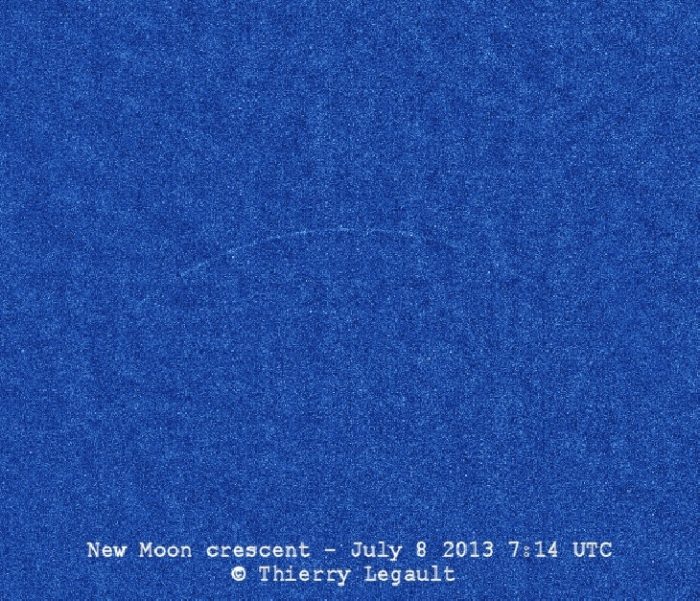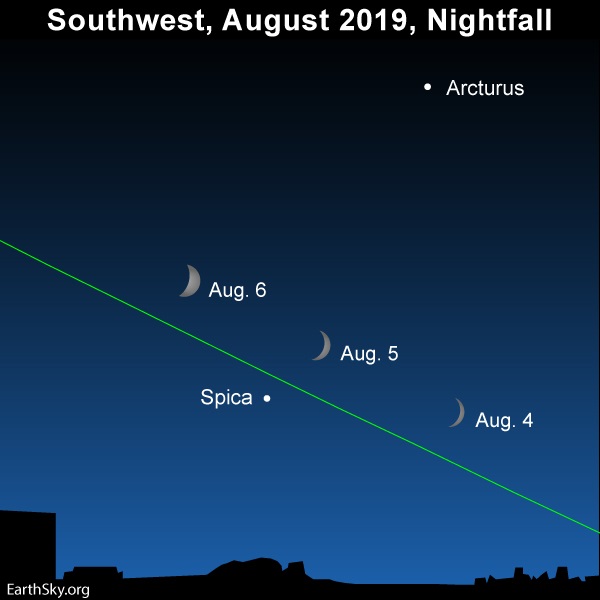

Youngest possible lunar crescent, with the moon’s age being exactly zero when this photo was taken — at the instant of new moon – 07:14 UTC on July 8, 2013. Image by Thierry Legault.
The next new moon falls on August 1, 2019, at 03:12 UTC; that is, July 31 at 23:12 p.m. EDT. Translate UTC to your time. For some parts of the world, then, this will be the second new moon of July, and thus some will called it a Black Moon. It’s also a supermoon. Following this new moon, you’ll likely see the young crescent moon again – in the west after sunset – in early August.
New moons can’t be seen, or at least they can’t without special equipment and a lot of moon-watching experience. The photo at the top of this post shows the moon at the instant it became new in July 2013. When the moon is new, it’s most nearly between the Earth and sun for any particular month. There’s a new moon about once a month, because the moon takes about a month to orbit Earth. The moon is nearly between the Earth and sun. In most months, there’s no eclipse because, most of the time, the new moon passes not in front of the sun, but simply near it in our sky.
Either way – in front of the sun or just near it – on the day of new moon, the moon travels across the sky with the sun during the day, hidden in the sun’s glare.
A day or two after each month’s new moon, a slim crescent moon always becomes visible in the west after sunset. In the language of astronomy, this slim crescent is called a young moon by astronomers. When you can you expect to see the moon in the evening again? Probably around August 4, 5 or 6, when it’ll appear in the sunset direction for a brief time after sunset.
New moons, and young moons, are fascinating to many. The Farmer’s Almanac, for example, still offers information on gardening by the moon. And many cultures have holidays based on moon phases.

Watch the young moon – a slim crescent moon visible in the west after sunset – swing past the star S;pica on August 4, 5, and 6, 2019. Read more.
Bottom line: New moon is August 1, 2019, at 03:12 UTC; that is, July 31 at 23:12 p.m. EDT. Translate UTC to your time.
Read more: Spot the young moon in early August, 2019
Read more: 4 keys to understanding moon phases
Read more: EarthSky’s guide to the bright planets
Help EarthSky keep going! Please donate.
from EarthSky https://ift.tt/2QpMvsB


Youngest possible lunar crescent, with the moon’s age being exactly zero when this photo was taken — at the instant of new moon – 07:14 UTC on July 8, 2013. Image by Thierry Legault.
The next new moon falls on August 1, 2019, at 03:12 UTC; that is, July 31 at 23:12 p.m. EDT. Translate UTC to your time. For some parts of the world, then, this will be the second new moon of July, and thus some will called it a Black Moon. It’s also a supermoon. Following this new moon, you’ll likely see the young crescent moon again – in the west after sunset – in early August.
New moons can’t be seen, or at least they can’t without special equipment and a lot of moon-watching experience. The photo at the top of this post shows the moon at the instant it became new in July 2013. When the moon is new, it’s most nearly between the Earth and sun for any particular month. There’s a new moon about once a month, because the moon takes about a month to orbit Earth. The moon is nearly between the Earth and sun. In most months, there’s no eclipse because, most of the time, the new moon passes not in front of the sun, but simply near it in our sky.
Either way – in front of the sun or just near it – on the day of new moon, the moon travels across the sky with the sun during the day, hidden in the sun’s glare.
A day or two after each month’s new moon, a slim crescent moon always becomes visible in the west after sunset. In the language of astronomy, this slim crescent is called a young moon by astronomers. When you can you expect to see the moon in the evening again? Probably around August 4, 5 or 6, when it’ll appear in the sunset direction for a brief time after sunset.
New moons, and young moons, are fascinating to many. The Farmer’s Almanac, for example, still offers information on gardening by the moon. And many cultures have holidays based on moon phases.

Watch the young moon – a slim crescent moon visible in the west after sunset – swing past the star S;pica on August 4, 5, and 6, 2019. Read more.
Bottom line: New moon is August 1, 2019, at 03:12 UTC; that is, July 31 at 23:12 p.m. EDT. Translate UTC to your time.
Read more: Spot the young moon in early August, 2019
Read more: 4 keys to understanding moon phases
Read more: EarthSky’s guide to the bright planets
Help EarthSky keep going! Please donate.
from EarthSky https://ift.tt/2QpMvsB

Aucun commentaire:
Enregistrer un commentaire